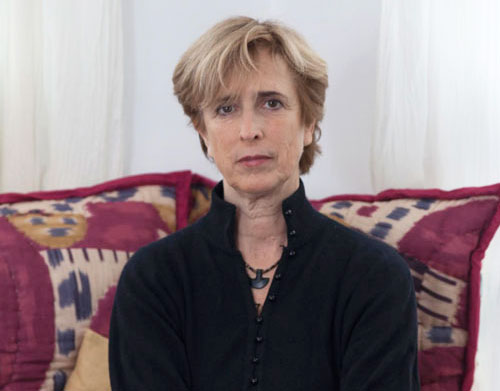
Valerie Hird. Photograph: Matthew Thorsen. Courtesy Seven Days.
by JANET McKENZIE
Janet McKenzie: Your works in the exhibition Location, at the Jam Jar Gallery in Dubai, to accompany Crossing the Line 2 (now exhibiting at Langford 120, in Melbourne) impressed me in the way that they cut through the stereotypes we have in the west about the role of women in the Middle East. Western media coverage of conflict, and television dramas such as Homeland and NCIS, have contributed to the barrier that exists in our understanding of other cultures. It is difficult to access contemporary art – film, literature and the visual arts – from the Middle East. Can you describe how you came to define and execute the Maiden Voyages Project (2009)?
Valerie Hird: I wish I could say that the situation has changed since the war in Iraq began, but the American press and television drama is awash with overworked crisis metaphors. When nuance and perspective exits my media feed, it exits my conversations as well. And when I start speaking in extremes, I start to think that way too. It’s impossible for me not to wonder how much they contribute to our cultural perception creep. The idea for the project was to inject a little reality into our image of people – and of women, in particular – in the Middle East.
To prepare, I read journals of other women in the arena of war. We’ve probably all read The Diary of Anne Frank. Its searing effect on the reader is more about when it was written and what happened to the author. The diary content itself – which touches only tangentially on the history that was taking place around her – is the daily observations of a normal teenager growing up. I also read journals from our own American civil war: Mary Chesnut’s Civil War, edited by C Vann Woodward, and The Women’s War in the South compiled by Charles Waugh and Martin Greenberg. Not surprisingly, they talked mainly about the daily challenges of keeping their children fed, tending sick relatives and getting the cows corralled at night. Very little was devoted to the discussion of the war raging around them. Their letters and journals suggested a much richer narrative than what we remember from our own history books. That might be OK within our own culture, because we know there’s more to the story if we choose to look. Just as we know that news events taking place in our country have more to them than the press reports. Yet we’re complacent about allowing the New York Times and the Daily Beast, and TV dramas such as Homeland or NCIS, to construct our impressions of people in the Middle East and Islam. We don’t seem to pause and remember that it is the media’s job to sell papers and score ratings, and they do it by reporting crises and creating drama.
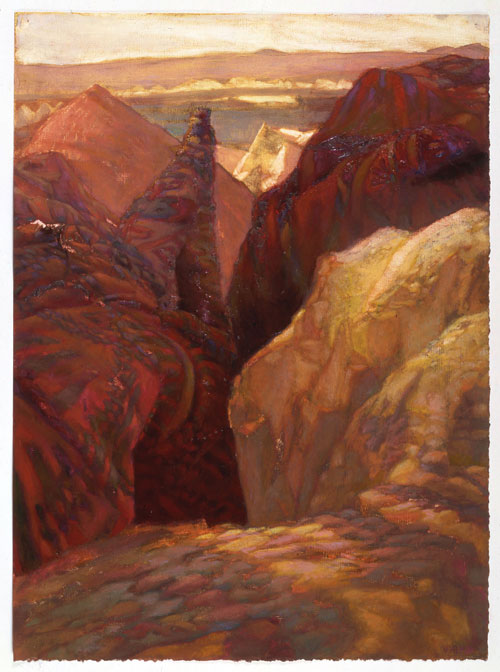
Valerie Hird. Nomadic Landscape II, 1993. Oil on gessoed paper, 26 1/8 x 19 1/8 in (66.2 x 48.3 cm). Courtesy of the artist and Nohra Haime Gallery.
I wanted Maiden Voyages to be a kind of anti-toxin to counter the viral spread of media hype. And I wanted to do it by focusing on actual lives, the small daily dramas, and the parts least newsworthy but most easily recognised and accessed by all of us. I also wanted to do it entirely as image-based narratives – graphic narratives, specifically – because they are visually compelling and could skip over the problems of text translation. I wanted not only an American audience, but also audiences in the Middle East: Israelis, Jordanians, Egyptians, Iranians, and Turks, few of whom share common languages.
I wanted to create these visual journals and present them on the internet with free access. I wanted the journals to have a handmade look. I didn’t want a Pixar polish for the animated sequences. I wanted them to look like real journals. The Maiden Voyages Project (maidenvoyagesproject.com) are my hand-drawn interpretations of five year-long diaries written by contemporary women: one American (myself) and four whom I contacted, from the Middle East (Iran, Jordan, Egypt and the Palestinian West Bank). We agreed to write about a single day – the first day of each month – for a year. I took their texts and translated them into image-based narratives.
JMcK: You teach a cross-cultural arts programme in New York and Jordan to explore accurately the diverse cultures there and to seek to heighten the nature of [western] pluralism. These are urgent issues: what methodology do you employ with the students in both countries?
VH: I first developed the course as a collaborative project between students at Saint Michael’s College in Colchester, Vermont, and the University of Jordan in Amman. I teach a full-semester course at Champlain College in Burlington, Vermont, and I may be teaching an intensive version for New York University Abu Dhabi in 2016. The course is interdisciplinary. It was developed for non-artists and draws from anthropology, creative writing, semiotics, performance and graphic arts.
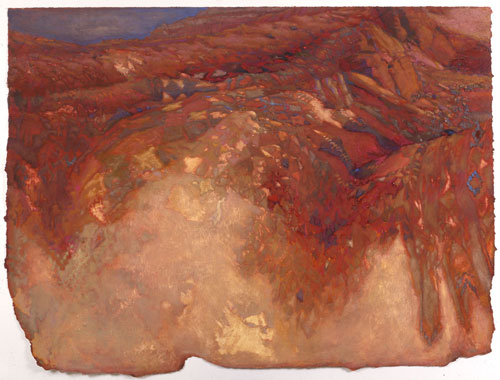
Valerie Hird. Steppe Kilim II, 1994. Oil on paper, 36 3/4 x 49 in (94.3 x 124.5 cm). Courtesy of the artist and Nohra Haime Gallery.
Whenever possible, I like to use primary sources; the students themselves and first-person interviews via Skype with individuals from the countries they are studying. Before examining text and media for potential cross-cultural reality checks, students first become sensitised to their own – very localised – cultural symbols. All of us, and the media, are already using visual language everyday to communicate at every level of community. We are trained from infancy to recognise visual clues in our own physical environment – what we wear, and the variety of media we watch, stream or read. Many of our generalisations and stereotypes are formed here. I wanted to create a course that would challenge students to “unpack” those visual signals, decode them, then turn them around, acquired afresh for their own use. Only after students have identified visual symbols that are accessible within their own communities can they begin to distinguish them from visual symbols that have a significance that is wider than – or different from – those from other cultures and the global “meta-culture”.
By the end of a term, students create their own personal narratives and post them online for a real audience reaction. Meaningful connections are made through the process of feedback and online editing of these visual stories. Working with my colleague Rula Quawas from the University of Jordan, our students exchange narratives and provide feedback to each other through email. Several have remained penpals.
JMcK: Collaboration and communication underpin your teaching project. What do you hope to achieve, both in terms of individual self-realisation and defining visual language and critique?
VH: The distance between cultures is as complex as our own individual psyches. We all have a natural tendency to compartmentalise each other, while simultaneously maintaining the belief that we, personally, are uniquely complex individuals. And while I have no illusions that our cultural differences can be eliminated in a happy post-cultural future, I would like our students to understand how to form their opinions of other cultures based as much as possible on personal exchange – not on media entertainment.
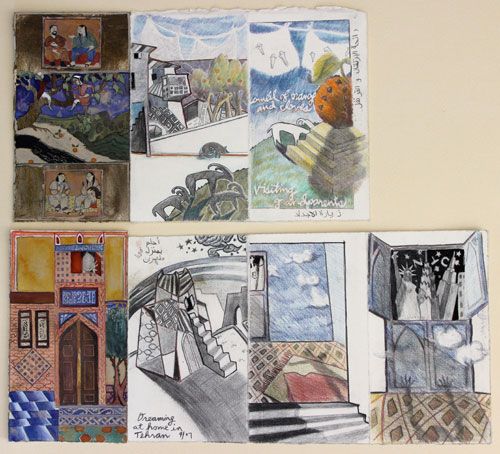
Valerie Hird. Iran Diary, July and October entries (Maiden Voyages Project), 2009. Graphite, watercolour, asphaltum, ink, and coloured pencil on arches paper, 18.5 x 31.5 cm and 18.5 x 42 cm.
JMcK:How does drawing, as opposed to other visual art forms, enable you to progress your aims in teaching?
VH: Drawing is uniquely suited to thought. It’s accessible and portable, and can be easily reworked. Drawings are documents of honest and wonderfully human communication. The gestural marks are often unique to their maker – like a signature. It was the first method of telling a story, and it remains a fantastically useful – back to the future – strategy for communicating in our globalised world.
JMcK: You studied as an archaeological illustrator at Beloit College in Wisconsin, transferred to the Rhode Island School of Design to major in painting, and then became a compulsive traveller. Can you explain what fuelled your interest in nomad cultures and where you went?
VH: I think from the womb I was hard-wired to travel. As a child, I was enthralled by the stories and romance of “the Orient”. I was a bookish kid, whose physical world was circumscribed by exotic textiles and objects collected by my grandparents who travelled extensively in the near and Far East, and I was quickly drawn to visual patterns and narrative. My mind sits between empirical observation and a more metaphorical world. And the way to enter my creative world is through patterned textiles and stories. When travelling through the Anatolian Steppes – the spectacular geological formations, the plants and animals – all seemed to be the physical manifestations of stylised symbols that I saw reproduced in the area’s textiles.
It happens to me all the time. One structure will reference another. (I wonder if that is how patterns recur between totally unrelated societies.) Colour is my drug of choice. And colour is at the heart of the nomad’s greatest textiles. Colour drives and defines both our art forms. It is colour as pattern that continues to intrigue and dazzle me. That dual dialogue – visually compelling as well as a loosely defined language – makes me crazy.
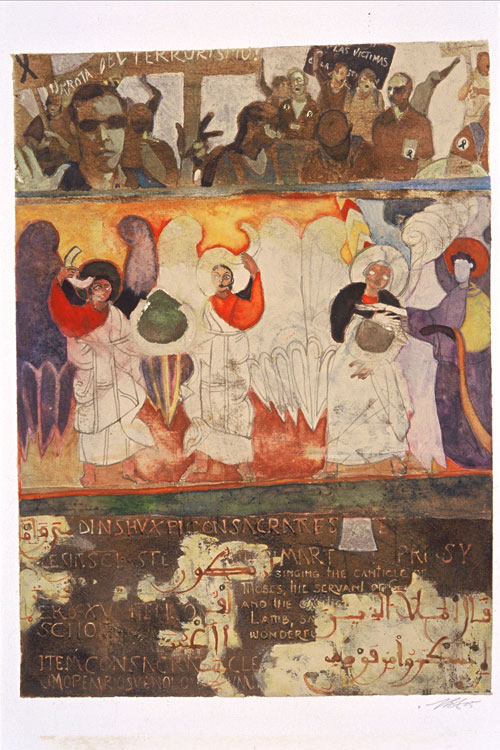
Valerie Hird. Illuminated Cycles of Christianity, 2005. Gouache, watercolour, asphaltum, gilding, and gesso on BFK paper, 11 1/2 x 8 1/2 in (29.2 x 21.6 cm). Courtesy of the artist and Nohra Haime Gallery.
The other thing that made the nomads so fascinating to me was their stories. A nomadic sense of geography is all about stories. If you asked a nomad where they were going, they would answer from the perspective of narrative. The place where you agreed to meet up would be where such and such a battle took place, or a child died, or lovers met … and died. And since everybody grew up listening to the same stories, everybody knew where the place was. I listened to many fascinating “historical” narratives – always entertaining, instructive – and I learned the indisputable truth that, no matter how many versions I heard, the one being told was the true one. I used to think this was unique to oral cultures, but age has taught me that revisionist history is a shared strategy across cultures.
I have always liked Salman Rushdie’s quote from Midnight’s Children about memory and truth: “… memory has its own special kind of truth. It selects, eliminates, alters, exaggerates, minimises, glorifies and vilifies also – but in the end it creates its own reality … and no sane human being ever trusts someone else’s version more than his own”.
I became really interested in these stories. After a while, I thought I might pick up earlier versions by travelling to areas that were closer to Mongolia – where many think the Turkic tribes originated. So I took myself to Central Asia.
JMcK: You lived among the Bedouin, Berber, Turkic and Kirghiz people regularly from your initial travels until 2005. Can you explain in practical terms how you manage this as a western woman?
VH: I was never cut out to be an archaeological illustrator. But I had been trained as one. Initially, those skills could be traded to give me access to archaeologists working in places and with the people who really held my interest, the remaining semi-nomads. These were groups outside, and distinctly different from, what we now think of as Middle Eastern cultures. Initially, I would trade my services as an illustrator to field archaeologists for access to my areas of interest. But later, as I became more confident, I went my own way by hiring a guide who could introduce me to families still making seasonal migrations. Even in the 1990s, many of denizens of Marrakech, Istanbul and Cairo were only first or second-generation urbanites. Most had extended families still roaming the mountainous regions. Hospitality to strangers is a primary cultural trait. So for a month I could be hosted by a family without creating too much of a disruption. The families never accepted payment for their hospitality, but according to custom, all visitors should bring a house gift. Mine was always food. The Turkic family I stayed with had no word for “artist: as we know it. And, as a single American woman, I had no value beyond being a curiosity. So to fit in, I would spend most of my time with the women, learning their chores and dialects. I think I can say I’m sorry in about seven different languages!
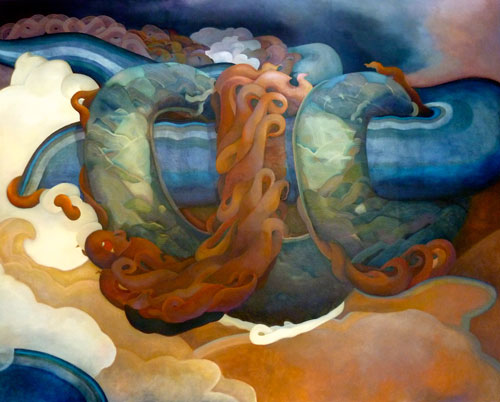
Valerie Hird. Origination I, 2014. Oil on canvas, 96 x 120 in (243.8 x 304.8 cm). Courtesy of the artist and Nohra Haime Gallery.
Of all my hosts, I was closest to my Moroccan family. And though mostly settled, their lifestyle still kept many nomadic habits. Their compounds are made up of huge extended families – set up, like a nomadic camp around the home of the family elder. Each morning, we women collected straw for the fire to make bread. The patriarch was amazing, over 80, with no health issues. His eyesight was excellent. He could walk for miles. They never accepted money – directly – for my stay. But on my last day, I walked the several miles to market with him, where he spent the morning choosing a sheep that I then arranged to pay for. Just watching him expertly eyeball the animals, then haggle over price warped me right back to my childhood farm in Vermont. Our county fairs there were dominated by tough old Scots.
JMcK: In your paintings Nomadic Landscape (1995) and Steppe Kilim (1995), the marvellous woven rugs are projected on to, or fused with, the rugged terrain in the places where they are woven. The rugs you have collected in the Middle East and in Central Asian countries are woven exclusively by women and contain vital narratives. Can you explain their significance as “cultural icons” and in terms of your own lexicon of forms?
VH: Textiles, for me, hold the power of association. They have memory. How many of us are instantly warped back to a specific place and time by a beloved garment? What people wear is a huge clue to who they are. It’s an immensely powerful form of visual language. Nomadic textiles, their rugs and clothing when seen in context, reveal a specific character and a drape unique to their usage. At one time, they also served the very practical purpose of identifying, by symbols and by colour, the family group and region where they were based. Symbols woven or embroidered on fabric could ward off predators, speak about the hopes and dreams of the young weaver, or ask for protection from their animist gods. The tribal weavers – always women – intermarried over time, and the designs and patterns merged between tribes. It is why you don’t hear a lot of ethnographers and anthropologists talking about its image-based vocabulary – because it shifts and is unquantifiable. But for me – for artists – the concept of co-opting and incorporating a design for its aesthetic value is very familiar. We have been doing it for centuries. It is something that makes perfect sense.
My work is deeply rooted in multiple cultures. The nomadic icons I use are filtered through my own cultural roots to create a transcultural and transnational hybrid that hopefully rejects a simple binary east/west interpretation.
JMcK: Your recent work is very personal and very much the product of working as an artist for 40 years. Can you describe how you live between these two worlds of Vermont in the US and Middle Eastern countries such as Jordan?
VH: I would like to think I’ve grown beyond a bi-local or even tri-local sensitivity, but have developed – like many contemporary artists today – a more global perspective. The conversations I’m interested in having with my viewers now are a result of the years I’ve spent moving across cultures and developing a sense of what is both local and universal. I’m particularly interested in how different cultural icons juxtaposed in the same painting or drawing impact viewers in different countries and cultures.
JMcK: Your most recent exhibition Origination at the Nohra Haime Gallery in New York City (October-November 2014) focused on creation myths and the natural world. How did this ambitious body of work come about?
VH: After years of working on projects in the political cauldron of the Middle East – in the midst of cultural clashes, religious conflict, and endless rhetoric – I was completely overwhelmed by our conflicted civilisations. Maybe like the post first world war surrealists, I was haunted by war and longed for a new collective mythos. To find and explore this new mythology, I decided to leave humans out of the equation for a while and discuss the wild, messy jumble of similarity and difference, adaptability and extinction in purely organic terms. After all, the opposite of war in the natural world isn’t peace: it’s creation.
JMcK: Can you explain the body of work in terms of the wide range of motifs or symbols from different cultures that you have incorporated?
VH: I pulled a warehouse of memory from all my sources, the stories the nomads told me, as well as all the miraculous explanations for our world that I’ve collected over my 60 years. I’ve retasked them to tell my story. In addition, I’ve used the concept of the sacred tree from Norse, Assyrian, and Pacific Northwest mythologies. I have used the iconography from Ferdowsi’s watercolours in the Shahnemah to describe water and landscape, as well as Chinese textiles to show depictions of water, sky and clouds. I have drawn from the Hindu and Buddhists’ brilliant gouaches to depict fire and wind. Celtic knots wind through my landscapes. Many vocabularies from many cultures are used to describe my natural world. The older I get, I find that certain systems work, be they human or natural, and they recur again and again. So as you see my world unfolding in this decade, you can follow the strands, and hopefully become meshed in my world and leave behind our polarised present.
JMcK: Can you relate the meaning of your imagery in Illuminated Cycles of Christianity (2005)?
VH: Illuminated Cycles of Christianity was one of a pair of mixed media paintings on paper. The other was Illuminated Cycles of Islam. They were created in reaction to the Madrid train bombings in 2004. I wanted to place that event in the context of historical memory and the shared cycle of violence between Islam and Christianity. Using the format of medieval illumination, I cast the top image in the present – street protests mourning the loss of life. The middle is a rendering of a medieval image from the present dominant religion. The bottom image is composite of past and present. In Cycles of Christianity, the bottom image is from Cordoba’s Alcázar, and it describes a wall, originally constructed with Islamic text, now partially covered over with Christian text. In Cycles of Islam, the bottom image is taken from Istanbul’s Hagia Sophia, showing wall text from the original Christian construction that was then covered with Islamic text. Taken together, they have an integrated aesthetic of their own. A point that art can make, but which perhaps loses in translation to our politicised world.